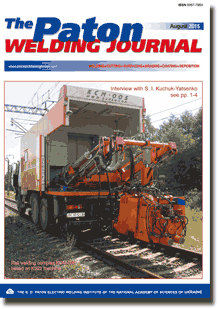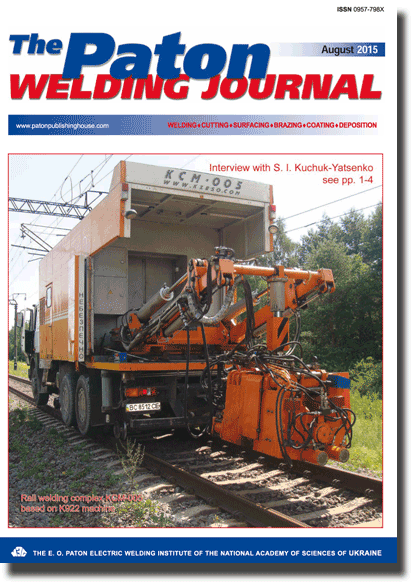| 2015 №08 (08) |
DOI of Article 10.15407/tpwj2015.08.09 |
2015 №08 (10) |

The Paton Welding Journal, 2015, #8, 43-46 pages
Erosion resistance of Cr-Ni-Si metal in surfacing in different shielding environments
Yu.I. Lopukhov
East Kazakhstan State Technical University. 34, 30 Gvardejskoj Divizii Str., 070002, Ust-Kamenogorsk, Kazakhstan. E-mail: kanc_ekstu@mail.ru
Abstract
Pipeline stop valves during operation should possess the erosion resistance of sealing surfaces. For this purpose they are subjected to mechanized arc surfacing with producing of high-alloyed Cr-Ni-Si deposited metal. Further improvement of erosion resistance can be achieved by additional alloying of deposited metal using nitrogen. The paper presents the results of comparative tests of the deposited metal on tear resistance in surfacing using flux-cored wire in argon, carbon dioxide, nitrogen and mixture of nitrogen with carbon dioxide. The best indicators of erosion resistance belong to the deposited metal produced during surfacing in mixture of nitrogen and carbon dioxide. 2 Ref., 3 Tables, 1 Figure.
Keywords: arc surfacing, mixture of shielding gases, stop valves of pipelines, sealing surfaces, flux-cored wire, Cr-Ni-Si deposited metal, erosion resistance
Received: 15.04.15
Published: 13.10.15
References
- Stepin, V.S., Starchenko, E.G., Andreev, A.A. (2006) Application of dispersion-hardened Cr-Ni-Si steels for valve components and cladding of seal faces of fittings of thermal and nuclear power plants. Armaturostroenie, 3, 66-69.
- Lopukhov, Yu.I. (2009) Formation of structure of chrome-nickel-silicon steel in conditions of gas-arc surfacing. Fizich. Inzheneriya Poverkhnosti, 7(1/2), 27-30.
Suggested Citation
Yu.I. Lopukhov (2015) Erosion resistance of Cr-Ni-Si metal in surfacing in different shielding environments. The Paton Welding J., 08, 43-46.The cost of subscription/purchase order journals or individual articles
| Journal/Currency | Annual Set | 1 issue printed |
1 issue |
one article |
| TPWJ/USD | 384 $ | 32 $ | 26 $ | 13 $ |
| TPWJ/EUR | 348 € | 29 € | 24 € | 12 € |
| TPWJ/UAH | 7200 UAH | 600 UAH | 600 UAH | 280 UAH |
| AS/UAH | 1800 UAH | 300 UAH | 300 UAH | 150 UAH |
| AS/USD | 192 $ | 32 $ | 26 $ | 13 $ |
| AS/EUR | 180 € | 30 € | 25 € | 12 € |
| SEM/UAH | 1200 UAH | 300 UAH | 300 UAH | 150 UAH |
| SEM/USD | 128 $ | 32 $ | 26 $ | 13 $ |
| SEM/EUR | 120 € | 30 € | 25 € | 12 € |
| TDNK/UAH | 1200 UAH | 300 UAH | 300 UAH | 150 UAH |
| TDNK/USD | 128 $ | 32 $ | 26 $ | 13 $ |
| TDNK/EUR | 120 € | 30 € | 25 € | 15 € |
AS = «Automatic Welding» - 6 issues per year;
TPWJ = «PATON WELDING JOURNAL» - 12 issues per year;
SEM = «Electrometallurgy Today» - 4 issues per year;
TDNK = «Technical Diagnostics and Non-Destructive Testing» - 4 issues per year.


